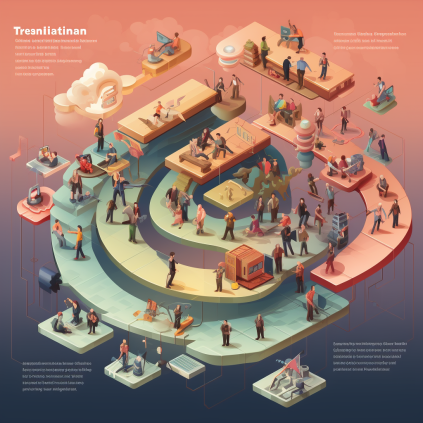Introduction
Transition and Transformation: In today’s dynamic technological landscape, software development is at the heart of innovation and progress. As companies adapt to changing market demands, mergers and acquisitions, or simply seek to improve efficiency, there often arises a need to transition or transform software development from one team to another. This process is not merely a matter of transferring code; it involves a complex interplay of skills, culture, and technology. In this article, we will delve deep into the intricacies of transitioning and transforming software development teams, highlighting key challenges, strategies, and real-world examples that demonstrate how this transition can be successfully executed.


Transition and Transformation
Table of Contents
I. Understanding the Need for Transition
1.1. Market Dynamics and Business Strategies
Software development teams often undergo transitions due to shifts in a company’s market strategy. For example, when a company decides to pivot from a legacy software product to a new, more cutting-edge solution, it may necessitate transitioning from an old development team to a new one.
1.2. Mergers and Acquisitions
Mergers and acquisitions (M&A) are another common scenario that drives transitions in software development. When two companies merge or one acquires another, the integration of software development teams becomes a critical task. This transition involves harmonizing processes, technologies, and personnel.
Example: In the merger of Company A and Company B, the software development teams had to transition to a unified framework to ensure seamless collaboration. They implemented agile methodologies to enhance productivity and communication.
II. Key Challenges in Transitioning Software Development


2.1. Knowledge Transfer
One of the primary challenges in transitioning software development is transferring knowledge from the existing team to the incoming team. This includes understanding the existing codebase, architecture, and the reasoning behind design decisions.
2.2. Cultural Alignment
Different development teams often have distinct work cultures, values, and norms. Aligning these cultures is crucial to ensure a smooth transition. A culture clash can lead to inefficiencies and resistance to change.
2.3. Technology Stack Integration
In many cases, the incoming team may prefer different tools, programming languages, or frameworks. Ensuring a seamless integration of these technologies can be challenging.
Example: When Company X acquired Company Y, the two teams had to merge their software development efforts. They successfully overcame the challenge by conducting joint workshops to discuss best practices, fostering open communication, and gradually aligning their work cultures.
III. Transitioning vs. Transforming: What’s the Difference?
3.1. Transitioning
Transitioning typically involves moving an existing software development team from one department to another within the same company or from one company to another while maintaining the existing processes and technology stack.
3.2. Transforming
Transformation, on the other hand, goes beyond mere transition. It implies a fundamental change in the way software development is carried out. This often involves adopting new methodologies (e.g., Agile or DevOps), technologies, and workflows.
Example: Company Z transitioned its traditional software development team to a DevOps-focused team, thus transforming its development process. This move resulted in faster deployment and improved collaboration among cross-functional teams.
IV. Strategies for Successful Transition and Transformation


4.1. Clear Communication
Effective communication critical for a successful transition. It is essential to convey the reasons behind the transition, the expected outcomes, and the roles and responsibilities of team members.
4.2. Training and Skill Development
Providing training and opportunities for skill development is crucial, especially when transitioning to new technologies or methodologies. Investing in team members’ growth ensures a smoother transition.
Example: When transitioning to cloud-native development, Company M organized training sessions for its developers to become proficient in containerization and microservices architecture.
4.3. Gradual Transition
In some cases, it may be beneficial to implement a gradual transition. This involves having members of the incoming team work alongside the existing team for a period to learn the ropes and ensure a smooth handover.
V. Real-world Examples of Successful Transitions
5.1. Transition and Transformation: The Agile Transformation at XYZ Inc.
XYZ Inc., a multinational corporation, decided to transition its software development teams to Agile methodologies. They introduced Scrum and Kanban practices, which led to improved collaboration, faster time-to-market, and better product quality. By providing comprehensive training and coaching, they ensured a smooth transformation.
5.2. Transition and Transformation: The Integration of Teams in the Healthcare Industry
Two healthcare companies, without revealing their names, merged their software development teams to enhance their patient management system. Through meticulous planning, a clear roadmap, and continuous communication, they successfully integrated their teams, aligning their goals and improving patient care.
Transition and Transformation : Conclusion
Transitioning and transforming software development from one team to another is a complex but often necessary process in the ever-evolving tech industry. It requires a deep understanding of the unique challenges involved, a strategic approach, and a commitment to fostering a culture of collaboration and growth.
By learning from real-world examples and implementing effective strategies, companies can navigate these transitions successfully. Whether driven by market dynamics, M&A activities, or a desire for innovation, the ability to transition and transform software development teams is a hallmark of adaptability and resilience in the modern business landscape.

